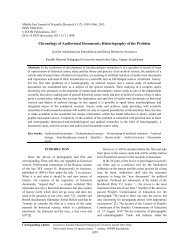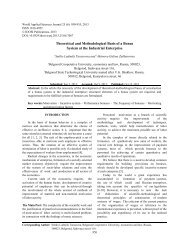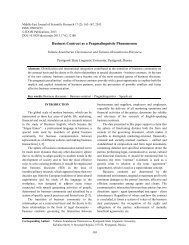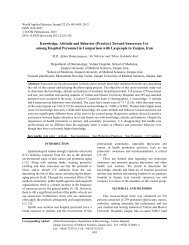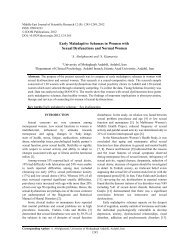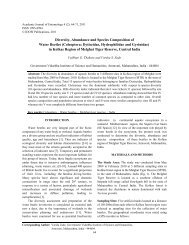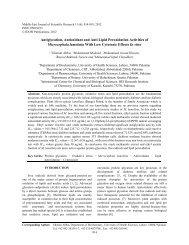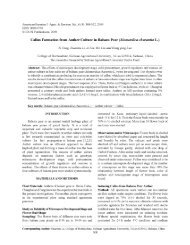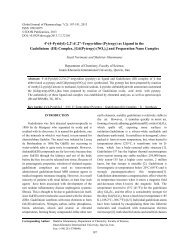Effect of Gums on Yogurt Characteristics - Idosi.org
Effect of Gums on Yogurt Characteristics - Idosi.org
Effect of Gums on Yogurt Characteristics - Idosi.org
Create successful ePaper yourself
Turn your PDF publications into a flip-book with our unique Google optimized e-Paper software.
World Applied Sciences Journal 20 (5): 661-665, 2012<br />
ISSN 1818-4952<br />
© IDOSI Publicati<strong>on</strong>s, 2012<br />
DOI: 10.5829/idosi.wasj.2012.20.05.2353<br />
<str<strong>on</strong>g>Effect</str<strong>on</strong>g> <str<strong>on</strong>g>of</str<strong>on</strong>g> <str<strong>on</strong>g>Gums</str<strong>on</strong>g> <strong>on</strong> <strong>Yogurt</strong> <strong>Characteristics</strong><br />
1 1 2 1<br />
Nima Hematyar, Azadeh Mohagheghi Samarin, Hashem Poorazarang and Amir Hossein Elhamirad<br />
1<br />
Department <str<strong>on</strong>g>of</str<strong>on</strong>g> Food Science and Technology, Faculty <str<strong>on</strong>g>of</str<strong>on</strong>g> Agriculture,<br />
Sabzevar Branch, Islamic Azad University, Sabzevar, Iran<br />
2<br />
Department <str<strong>on</strong>g>of</str<strong>on</strong>g> Food Science and Technology, Faculty <str<strong>on</strong>g>of</str<strong>on</strong>g> Agriculture,<br />
Ferdowsi University <str<strong>on</strong>g>of</str<strong>on</strong>g> Mashhad, Mashhad, Iran<br />
Abstract: The effects <str<strong>on</strong>g>of</str<strong>on</strong>g> xanthan and carrageenan gums at different c<strong>on</strong>centrati<strong>on</strong>s <strong>on</strong> the rheological,<br />
microbiological, chemical and sensory properties <str<strong>on</strong>g>of</str<strong>on</strong>g> yogurt were studied. The viscosity <str<strong>on</strong>g>of</str<strong>on</strong>g> samples c<strong>on</strong>taining<br />
gums increased compared to the c<strong>on</strong>trol sample. <strong>Yogurt</strong> samples with xanthan gum at a c<strong>on</strong>centrati<strong>on</strong> <str<strong>on</strong>g>of</str<strong>on</strong>g> 0.01%<br />
showed the highest viscosity during ten days storage. Syneresis <str<strong>on</strong>g>of</str<strong>on</strong>g> yogurt samples was measured at 4° C and<br />
25°C. The results showed that samples with gums had less syneresis during storage. Samples c<strong>on</strong>taining<br />
xanthan gum at a c<strong>on</strong>centrati<strong>on</strong> <str<strong>on</strong>g>of</str<strong>on</strong>g> 0.01% exhibited high resistance to syneresis during all days. pH and total<br />
solids <str<strong>on</strong>g>of</str<strong>on</strong>g> the samples did not change using gums during storage. In additi<strong>on</strong>, mould, yeasts and coliform groups<br />
were not detected in samples at the end <str<strong>on</strong>g>of</str<strong>on</strong>g> storage period. <strong>Yogurt</strong> treated with 0.005% xanthan gum gained the<br />
highest sensory score compared to the other treatments.<br />
Key words: <strong>Yogurt</strong> Syneresis Viscosity Xanthan Carrageenan<br />
INTRODUCTION<br />
Xanthan gum has been used to improve the texture,<br />
increase the firmness and prevent syneresis in yogurt<br />
The central process in c<strong>on</strong>versi<strong>on</strong> <str<strong>on</strong>g>of</str<strong>on</strong>g> milk to [12]. Carrageenan, synergistic with some other gums,<br />
yogurt is aggiomerati<strong>on</strong> <str<strong>on</strong>g>of</str<strong>on</strong>g> casein Micells into a could increase the gel strength and water binding<br />
three-dimensi<strong>on</strong>al network structure. Casein capabilities as well as modify the gel texture [13].<br />
c<strong>on</strong>stitutes about 80% <str<strong>on</strong>g>of</str<strong>on</strong>g> the total protein c<strong>on</strong>tent Syneresis can be reduced by adding stabilizers that<br />
<str<strong>on</strong>g>of</str<strong>on</strong>g> bovine milk and comprises four main comp<strong>on</strong>ents: interact with the casein network. The viscosity <str<strong>on</strong>g>of</str<strong>on</strong>g> yogurt<br />
s1, s2, and [1]. <strong>Yogurt</strong> has been attributed is affected by homogenisati<strong>on</strong>, pH, processing parameters<br />
nutraceutical, therapeutic [2] and probiotic effects [3], (stirred or set yoghurt) and heat treatment. A primary<br />
such as digesti<strong>on</strong> enhancement, immune system stabilizer, such as carboxymethyl cellulose (CMC), LBG,<br />
boosting, anticarcinogenic activity and reducti<strong>on</strong> in Alginate, or Guar, gum, can be used as a thickener in<br />
serum cholesterol [4, 5]. <strong>Yogurt</strong>s are increasingly popular c<strong>on</strong>juncti<strong>on</strong> with a sec<strong>on</strong>dary stabilizer, such as<br />
due to their nutriti<strong>on</strong>al and potentially therapeutic Carrageenan to reduce syneresis [14].<br />
characteristics [6]. <strong>Yogurt</strong> may have two primary defects: Various studies have been reported the use <str<strong>on</strong>g>of</str<strong>on</strong>g> gums<br />
variati<strong>on</strong> in viscosity and/or expulsi<strong>on</strong> <str<strong>on</strong>g>of</str<strong>on</strong>g> serum to improve some characteristics <str<strong>on</strong>g>of</str<strong>on</strong>g> yogurt [12, 15].<br />
(syneresis). Processing, incubati<strong>on</strong> and storage However, no informati<strong>on</strong> has been obtained <strong>on</strong> the effect<br />
c<strong>on</strong>diti<strong>on</strong>s have an effect <strong>on</strong> these changes. Dairy <str<strong>on</strong>g>of</str<strong>on</strong>g> xanthan and carrageenan at 0.01% and 0.005% <strong>on</strong><br />
ingredients and hydrocolloids have sometimes been yogurt characteristics. Therefore, this study was<br />
added to combat such defects [7-10]. In the realm <str<strong>on</strong>g>of</str<strong>on</strong>g> food undertaken to study the effect <str<strong>on</strong>g>of</str<strong>on</strong>g> <strong>on</strong>e adsorbing<br />
development, combinati<strong>on</strong> <str<strong>on</strong>g>of</str<strong>on</strong>g> more than <strong>on</strong>e type <str<strong>on</strong>g>of</str<strong>on</strong>g> polysaccharide (carrageenan) and <strong>on</strong>e n<strong>on</strong>-adsobing<br />
hydrocolloids in comm<strong>on</strong>ly used in food product, polysaccharide (xanthan), at 0.01% and 0.005% <strong>on</strong> yogurt<br />
modify rheological characteristic and satisfy processing rheology and some properties (pH, Total solids,<br />
requirement in the industry [11].<br />
syneresis) after <strong>on</strong>e, five and ten days <str<strong>on</strong>g>of</str<strong>on</strong>g> storage.<br />
Corresp<strong>on</strong>ding Author: Nima Hematyar, Department <str<strong>on</strong>g>of</str<strong>on</strong>g> Food Science and Technology,<br />
Faculty <str<strong>on</strong>g>of</str<strong>on</strong>g> Agriculture, Sabzevar Branch, Islamic Azad University, Sabzevar, Iran.<br />
Tel: +98 09126126135.<br />
661
World Appl. Sci. J., 20 (5): 661-665, 2012<br />
MATERIALS AND METHODS<br />
Statistical Analysis: Experimental data was analyzed<br />
using analysis <str<strong>on</strong>g>of</str<strong>on</strong>g> variance (ANOVA) and significant<br />
Materials: Commercial product Xanthan was purchased differences am<strong>on</strong>g means from triplicate analyses at<br />
from Merk, Germany. Carrageenan was obtained from (P < 0.05) were determined by Duncan’s multiple range<br />
Ceamsa, Spain. Lactobacillus delbrueckii ssp. bulgaricus test (DMRT) using the SAS System (SAS).<br />
and Streptococcus salivarius ssp. thermophilus were<br />
obtained from Yc-X11 Chr. Hansen, Copenhagen,<br />
RESULTS AND DISCUSSION<br />
Denmark. The fresh whole cow´s milk used in this study<br />
was obtained from Beihagh factory <str<strong>on</strong>g>of</str<strong>on</strong>g> Sabzevar, Iran. <str<strong>on</strong>g>Effect</str<strong>on</strong>g> <str<strong>on</strong>g>of</str<strong>on</strong>g> the <str<strong>on</strong>g>Gums</str<strong>on</strong>g> <strong>on</strong> Rheological Properties <str<strong>on</strong>g>of</str<strong>on</strong>g> <strong>Yogurt</strong>s:<br />
The results for the effect <str<strong>on</strong>g>of</str<strong>on</strong>g> various stabilizers and storage<br />
Preparati<strong>on</strong> <str<strong>on</strong>g>of</str<strong>on</strong>g> <strong>Yogurt</strong> Samples: Xanthan and period <strong>on</strong> viscosity and syneresis are shown in Table 1.<br />
carrageenan gums were added to milk at two The results reveal that the use <str<strong>on</strong>g>of</str<strong>on</strong>g> xanthan and<br />
c<strong>on</strong>centrati<strong>on</strong>s <str<strong>on</strong>g>of</str<strong>on</strong>g> each stabilizer, 0.005% and 0.01%. In all carrageenan gums at menti<strong>on</strong>ed c<strong>on</strong>centrati<strong>on</strong> rates<br />
cases, except the c<strong>on</strong>trol (without stabilizer), xanthan and noticeably increased the viscosity <str<strong>on</strong>g>of</str<strong>on</strong>g> yogurt as compared<br />
carrageenan gums were dissolved in a small quantity <str<strong>on</strong>g>of</str<strong>on</strong>g> to the c<strong>on</strong>trol during storage. Treatment with xanthan gum<br />
milk, then added to the rest. All treatments were heated to at a c<strong>on</strong>centrati<strong>on</strong> <str<strong>on</strong>g>of</str<strong>on</strong>g> 0.01% exhibited the highest<br />
90°C for ten minutes and rapidly cooled to 42°C, viscosity values during storage.<br />
inoculated with 2% yogurt starter and were then Xanthan and Carrageenan gums increased the<br />
distributed into 150 ml plastic cups and incubated at 42°C viscosity and decreased the syneresis <str<strong>on</strong>g>of</str<strong>on</strong>g> samples, which<br />
for four hours. The yogurt samples was placed in a was expected. This may be attributed to the interacti<strong>on</strong><br />
refrigerator at 4°C and analyzed after <strong>on</strong>e, five and ten between the gum and the milk porti<strong>on</strong> [18, 19]. The<br />
days <str<strong>on</strong>g>of</str<strong>on</strong>g> storage.<br />
yogurts with the higher c<strong>on</strong>centrati<strong>on</strong>s <str<strong>on</strong>g>of</str<strong>on</strong>g> gums had high<br />
viscosities. The syneresis <str<strong>on</strong>g>of</str<strong>on</strong>g> the yogurts after<br />
Rheological Analysis: Viscosity <str<strong>on</strong>g>of</str<strong>on</strong>g> yogurt was measured centrifugati<strong>on</strong> at 4°C and 25°C, for the trials with xanthan<br />
with a Brookfield rotati<strong>on</strong>al viscometer (Model DV3PR,<br />
and carrageenan revealed that the untreated yogurt<br />
Austria), fitted with a R 3–spindle at 30 rpm and 25° C. For samples had higher syneresis as compared to the yogurt<br />
determinati<strong>on</strong> <str<strong>on</strong>g>of</str<strong>on</strong>g> syneresis, samples (30 g) were samples treated with stabilizers. The mean for syneresis in<br />
centrifuged at 222 × g for 10 min at 4°C and 25°C and the case <str<strong>on</strong>g>of</str<strong>on</strong>g> untreated samples were 4 ml and 4.4 ml, at 4°C and<br />
extent <str<strong>on</strong>g>of</str<strong>on</strong>g> trapped serum phase quantified and expressed 8.3 ml and 11.5 ml, at 25°C after <strong>on</strong>e and ten days <str<strong>on</strong>g>of</str<strong>on</strong>g><br />
as the volume <str<strong>on</strong>g>of</str<strong>on</strong>g> separated whey (milliliters whey). storage, respectively. <strong>Yogurt</strong> samples c<strong>on</strong>taining xanthan<br />
Syneresis measurements were made in triplicate and the gum at a c<strong>on</strong>centrati<strong>on</strong> <str<strong>on</strong>g>of</str<strong>on</strong>g> 0.01% during storage had less<br />
average and absolute error range calculated [15].<br />
syneresis at 4°C and 25°C compared to the other samples.<br />
In each case including c<strong>on</strong>trol, the syneresis increased<br />
Chemical Analysis: Total solids <str<strong>on</strong>g>of</str<strong>on</strong>g> yogurt were with increasing storage time. Generally, syneresis<br />
determined as described by AOAC [16]. A pH meter decrease with increasing gums. All experimental<br />
(Model MTT 65, Germany) was used to measure the pH treatments had less syneresis than the c<strong>on</strong>trol sample.<br />
values at 20°C. Harwalker et al., 1986 [20] and Abd EI-Salam et al., 1996<br />
[21] have reported that the use <str<strong>on</strong>g>of</str<strong>on</strong>g> thickening agents such<br />
Microbiological Analysis: Mould and yeasts were as xanthan gum is being c<strong>on</strong>sidered as a method <str<strong>on</strong>g>of</str<strong>on</strong>g><br />
determined according to Harrigan and McCance [17] c<strong>on</strong>trolling syneresis <str<strong>on</strong>g>of</str<strong>on</strong>g> fermented milks. Ani<strong>on</strong>ic<br />
using malt extract. Coliform bacteria were determined hydrocolloids (e.g. CMC, pectin, carrageenan) interact<br />
according to Harrigan and McCance [17] using violet red with the positive charges <strong>on</strong> the surface <str<strong>on</strong>g>of</str<strong>on</strong>g> casein<br />
bile agar medium. micelles to strengthen the casein network and<br />
reduce syneresis and are classified as adsorbing<br />
Sensory Evaluati<strong>on</strong>: An experienced taste panel <str<strong>on</strong>g>of</str<strong>on</strong>g> fifteen polysaccharides. Neutral hydrocolloids (e.g. xanthan,<br />
stuff judges evaluated the yogurt samples for flavor (50 guar, LBG) do so through a different mechanism by<br />
points), texture (40 points) and appearance (10 points) increasing the viscosity <str<strong>on</strong>g>of</str<strong>on</strong>g> the c<strong>on</strong>tinuous phase and<br />
[12]. are classified as n<strong>on</strong>-adsorbing polysaccharides [14].<br />
662
World Appl. Sci. J., 20 (5): 661-665, 2012<br />
Table 1: Viscosity and syneresis <str<strong>on</strong>g>of</str<strong>on</strong>g> yogurt during refrigerated storage<br />
Syneresis (ml/30 g) Storage period, day<br />
-----------------------------------------------------------------------------------------------------<br />
Viscosity(cp) Storage period, day 1 5 10<br />
--------------------------------------------------- --------------------------- --------------------------- ------------------------<br />
Stabilizer used% 1 5 10 4°C 25°C 4°C 25°C 4°C 25°C<br />
C<strong>on</strong>trol(without)<br />
a<br />
2464<br />
a<br />
2672<br />
a<br />
2065<br />
a<br />
4<br />
a<br />
8.3<br />
a<br />
4.1<br />
a<br />
9.8<br />
a<br />
4.4<br />
a<br />
11.5<br />
Xanthan 0.01%<br />
b<br />
3438<br />
b<br />
3557<br />
b<br />
3791<br />
d<br />
1<br />
d<br />
3<br />
d<br />
1<br />
d<br />
3.7<br />
d<br />
1.1<br />
d<br />
4.5<br />
xanthan 0.005%<br />
b<br />
3084<br />
b<br />
3243<br />
b<br />
3456<br />
b<br />
2<br />
b<br />
7.6<br />
b<br />
2<br />
b<br />
9<br />
b<br />
2.3<br />
b<br />
9.7<br />
Carrageenan 0.01%<br />
b<br />
3194<br />
b<br />
3343<br />
b<br />
3554<br />
b<br />
1.8<br />
b<br />
7.1<br />
b<br />
1.9<br />
b<br />
8.4<br />
b<br />
2.1<br />
b<br />
8.9<br />
Carrageenan 0.005%<br />
b<br />
2884<br />
b<br />
3047<br />
b<br />
3206<br />
c<br />
2.4<br />
c<br />
7.9<br />
c<br />
2.5<br />
c<br />
9.3<br />
c<br />
2.9<br />
c<br />
10.2<br />
Means within a column with different superscript are significantly different (P < 0.05)<br />
Table 2: Changes in pH and total solids (TS) c<strong>on</strong>tents <str<strong>on</strong>g>of</str<strong>on</strong>g> yogurt during refrigerated storage<br />
pH Storage period, day<br />
Total solids (TS%) Storage period, day<br />
------------------------------------------------------------------------ -------------------------------------------------------------------------<br />
Stabilizer used% 1 5 10 1 5 10<br />
C<strong>on</strong>trol(without)<br />
a<br />
4.4<br />
a<br />
4.2<br />
a<br />
4.15<br />
a<br />
11.8<br />
a<br />
11.7<br />
a<br />
11.5<br />
Xanthan 0.01%<br />
a<br />
4.3<br />
a<br />
4.1<br />
a<br />
4<br />
d<br />
12.4<br />
d<br />
12.2<br />
d<br />
12<br />
xanthan 0.005%<br />
a<br />
4.2<br />
a<br />
4.1<br />
a<br />
3.9<br />
b<br />
12.1<br />
b<br />
11.8<br />
b<br />
11.6<br />
Carrageenan 0.01%<br />
a<br />
4.3<br />
a<br />
4.1<br />
a<br />
4<br />
b<br />
12.1<br />
b<br />
11.9<br />
b<br />
11.8<br />
Carrageenan 0.005%<br />
a<br />
4.3<br />
a<br />
4.1<br />
a<br />
4<br />
c<br />
11.9<br />
c<br />
11.7<br />
c<br />
11.6<br />
Means within a column with different superscript are significantly different (P < 0.05)<br />
Table 3: Sensory evaluati<strong>on</strong> <str<strong>on</strong>g>of</str<strong>on</strong>g> yogurt after 1 day<br />
Stabilizer used% Appearance (10) Body and texture (40) Flavor (50) Total (100)<br />
C<strong>on</strong>trol(without)<br />
a<br />
6<br />
ab<br />
30<br />
a<br />
35<br />
a<br />
71<br />
Xanthan 0.01%<br />
b<br />
8<br />
b<br />
25<br />
ab<br />
41<br />
ab<br />
74<br />
xanthan 0.005%<br />
b<br />
9<br />
c<br />
34<br />
b<br />
45<br />
b<br />
88<br />
Carrageenan 0.01%<br />
b<br />
9<br />
c<br />
35<br />
ab<br />
41<br />
b<br />
85<br />
Carrageenan 0.005%<br />
b<br />
8<br />
c<br />
33<br />
ab<br />
40<br />
b<br />
81<br />
Means within a column with different superscript are significantly different (P < 0.05)<br />
Carrageenan adopts a coil c<strong>on</strong>formati<strong>on</strong> under the i<strong>on</strong>ic manufacture respectively improved their <strong>org</strong>anoleptic and<br />
c<strong>on</strong>diti<strong>on</strong>s used in this study [22]. It may absorb to the rheological properties and that these results support the<br />
surface <str<strong>on</strong>g>of</str<strong>on</strong>g> casein micelles [23]. Adsorpti<strong>on</strong> <str<strong>on</strong>g>of</str<strong>on</strong>g> negatively applicati<strong>on</strong> <str<strong>on</strong>g>of</str<strong>on</strong>g> gums in the producti<strong>on</strong> <str<strong>on</strong>g>of</str<strong>on</strong>g> fermented dairy<br />
charged carrageenan <strong>on</strong>to the casein micelle surface may products.<br />
take place by electrostatic interacti<strong>on</strong> with the net<br />
positively charged moiety <str<strong>on</strong>g>of</str<strong>on</strong>g> - casein [24]. Apparent <str<strong>on</strong>g>Effect</str<strong>on</strong>g> <str<strong>on</strong>g>of</str<strong>on</strong>g> the <str<strong>on</strong>g>Gums</str<strong>on</strong>g> <strong>on</strong> Chemical and Microbiological<br />
viscosity <str<strong>on</strong>g>of</str<strong>on</strong>g> xanthan showed similar trends to the Properties <str<strong>on</strong>g>of</str<strong>on</strong>g> <strong>Yogurt</strong>s: The pH and total solids decreased<br />
n<strong>on</strong>-adsorbing polysaccharides, indicating that the throughout the storage period (Table 2). Results <str<strong>on</strong>g>of</str<strong>on</strong>g> the<br />
proposed casein interactive mechanisms may also be investigati<strong>on</strong> <strong>on</strong> pH values and TS c<strong>on</strong>tents <str<strong>on</strong>g>of</str<strong>on</strong>g> yogurt<br />
applicable to this stabilizer [25]. At higher c<strong>on</strong>centrati<strong>on</strong>s, samples showed that there was no significant difference<br />
the casein aggregates may be trapped within the between samples c<strong>on</strong>taining stabilizers and the c<strong>on</strong>trol<br />
increasingly viscous polysaccharide soluti<strong>on</strong>, sample (p
World Appl. Sci. J., 20 (5): 661-665, 2012<br />
These results are c<strong>on</strong>sistent with findings <str<strong>on</strong>g>of</str<strong>on</strong>g> 7. Abrahamsen, R.K. and T.B. Holmen, 1980.<br />
EI-Salam et al., 1996 [21], who reported that the type <str<strong>on</strong>g>of</str<strong>on</strong>g><br />
stabilizer had no effect <strong>on</strong> the development <str<strong>on</strong>g>of</str<strong>on</strong>g> acidity and<br />
the trend <str<strong>on</strong>g>of</str<strong>on</strong>g> total solids c<strong>on</strong>tent during the yogurt<br />
storage. No mould, yeasts or coliform groups were<br />
detected in any yogurt samples during refrigerated<br />
storage.<br />
Sensory <strong>Characteristics</strong>: Table 3 gives the average<br />
scores for sensory evaluati<strong>on</strong> <str<strong>on</strong>g>of</str<strong>on</strong>g> yogurt samples, as<br />
affected by using xanthan and carrageenan gums. The<br />
additi<strong>on</strong> <str<strong>on</strong>g>of</str<strong>on</strong>g> xanthan and carrageenan gums had no effect<br />
<strong>on</strong> the yogurt flavor. No undesirable flavor was detected<br />
in any <str<strong>on</strong>g>of</str<strong>on</strong>g> the treatments. However, they had different<br />
effects <strong>on</strong> the texture <str<strong>on</strong>g>of</str<strong>on</strong>g> yogurt. The yogurt c<strong>on</strong>taining<br />
xanthan gum at a c<strong>on</strong>centrati<strong>on</strong> <str<strong>on</strong>g>of</str<strong>on</strong>g> 0.005% gained the<br />
highest score, followed by the yogurt c<strong>on</strong>taining<br />
carrageenan gum at a c<strong>on</strong>centrati<strong>on</strong> <str<strong>on</strong>g>of</str<strong>on</strong>g> 0.01%, while the<br />
c<strong>on</strong>trol had the lowest total score.<br />
ACKNOWLEDGEMENTS<br />
We gratefully acknowledge partially financial support<br />
from the Sabzevar Azad University Research Council. We<br />
would like to thank Dr. Shirin Fazel-Hashemi University <str<strong>on</strong>g>of</str<strong>on</strong>g><br />
Washingt<strong>on</strong>, for reviewing and English improvement to<br />
the text <str<strong>on</strong>g>of</str<strong>on</strong>g> this manuscript.<br />
REFERENCES<br />
1. Fox, P.F. and P.L.H. McSweeney, 1998.<br />
Dairy Chemistry and Biochemistry, L<strong>on</strong>d<strong>on</strong>:<br />
Blackie Academic and Pr<str<strong>on</strong>g>of</str<strong>on</strong>g>essi<strong>on</strong>al.<br />
2. Sloan, A.E., 2001. Top 10 trends to watch and work<br />
<strong>on</strong> third biannual report. Food Technology,<br />
55(4): 38-40, 42, 44-50, 52, 54, 56, 58.<br />
3. Shah, N.P., 2001. Functi<strong>on</strong>al food from probiotics and<br />
prebiotics. Food Technology, 55(11): 41-53.<br />
4. Bertolami, M.C., 1999. Evaluati<strong>on</strong> <str<strong>on</strong>g>of</str<strong>on</strong>g> effects to new<br />
fermented milk products <strong>on</strong> primary<br />
hypercholesterolemia. European Journal <str<strong>on</strong>g>of</str<strong>on</strong>g> Clinical<br />
Nutriti<strong>on</strong>, 53: 97-110.<br />
5. Milo-Ohr, L., 2002. Nutraceuticals and functi<strong>on</strong>al<br />
foods. Food Technology, 56(10): 67-70.<br />
6. Aguirre-Mandujano, E., C. Lobato-Calleros Beristain<br />
C.I. Garcia and H.S. Vern<strong>on</strong>-Carter, 2009.<br />
Microstructure and viscoelastic properties <str<strong>on</strong>g>of</str<strong>on</strong>g><br />
low-fat yoghurt structured by m<strong>on</strong>oglyceride gels.<br />
LWT Food Science and Technology, 42: 938-944.<br />
<strong>Yogurt</strong> from hyperfiltrated and ultrafiltrated<br />
evaporated milk and from milk with added milk<br />
powder. Milchwissenschaft, 35: 339-402.<br />
8. Tamime, A.Y. and H.C. Deeth, 1980.<br />
<strong>Yogurt</strong>: Technology and biochemistry. Journal <str<strong>on</strong>g>of</str<strong>on</strong>g><br />
Food Protecti<strong>on</strong>, 43: 939-977.<br />
9. Modler, H.W., M.E. Lam<strong>on</strong>d, C.S. Lin, D. Frohlich<br />
and D.B. Emm<strong>on</strong>s, 1983. Physical and sensory<br />
properties <str<strong>on</strong>g>of</str<strong>on</strong>g> yogurt stabilized with milk proteins.<br />
Journal <str<strong>on</strong>g>of</str<strong>on</strong>g> Dairy Science, 66: 422-429.<br />
10. Klupsch, H.J., 1989. Milchpulver in sauren Milch<br />
produkten. Ergebnisse praxisbezogener Versuch.<br />
Molkereitechnik, 82/83: 133-142.<br />
11. Norziah, M.H., S.L. Foo and A.B.D. Karim, 2006.<br />
Rheological studies <strong>on</strong> mixtures <str<strong>on</strong>g>of</str<strong>on</strong>g> agar<br />
(Gracilaria changii) and –carrageenan.<br />
Food Hydrocolloids, 20: 204-217.<br />
12. El-Sayed, E.M., I.A. El-Gawad, H.A. Murad and<br />
S.H. Salah, 2002. Utilizati<strong>on</strong> <str<strong>on</strong>g>of</str<strong>on</strong>g> laboratory-produced<br />
xanthan gum in the manufacture <str<strong>on</strong>g>of</str<strong>on</strong>g> yogurt and soy<br />
yogurt. European Food Research and Technology,<br />
215: 298-304.<br />
13. Ertan, A., K. Selim and P. Onder, 2009.<br />
Synergistic effect <str<strong>on</strong>g>of</str<strong>on</strong>g> the locust bean gum <strong>on</strong> the<br />
thermal phase transiti<strong>on</strong>s <str<strong>on</strong>g>of</str<strong>on</strong>g> -carrageenan gels.<br />
Food Hydrocolloids, 23: 451-459.<br />
14. Hansen, P.M.T., 1993. Food hydrocolloids in<br />
the dairy industry. In K. Nishinari. and E. Doi<br />
(Eds). Food hydrocolloids: structures, properties<br />
and functi<strong>on</strong>s. New York: Plenum press,<br />
pp: 211-224.<br />
´<br />
15. Keogh, M.K. and B.T. O Kennedy, 1998. Rheology <str<strong>on</strong>g>of</str<strong>on</strong>g><br />
stirred yogurt as affected by added milk fat Protein<br />
and hydrocolloids. Journal <str<strong>on</strong>g>of</str<strong>on</strong>g> Food Science,<br />
63(1): 108-112.<br />
16. A.O.A.C., 1990. Official Methods <str<strong>on</strong>g>of</str<strong>on</strong>g> analysis.<br />
15th edn Associati<strong>on</strong> <str<strong>on</strong>g>of</str<strong>on</strong>g> Official Analytical Chemists,<br />
USA.<br />
17. Harrigan, W.F. and M.E. McCance, 1966.<br />
Laboratory methods in microbiology. Academic,<br />
L<strong>on</strong>d<strong>on</strong>.<br />
18. Grindrod, J. and T.A. Nickers<strong>on</strong>, 1968. <str<strong>on</strong>g>Effect</str<strong>on</strong>g> <str<strong>on</strong>g>of</str<strong>on</strong>g><br />
various gums <strong>on</strong> skimmilk and purified milk proteins.<br />
Journal <str<strong>on</strong>g>of</str<strong>on</strong>g> Dairy Science, 51: 834-841.<br />
19. Schmidt, K.A. and D.E. Smith, 1992.<br />
Rheological properties <str<strong>on</strong>g>of</str<strong>on</strong>g> gum and milk protein<br />
interacti<strong>on</strong>s. Journal <str<strong>on</strong>g>of</str<strong>on</strong>g> Dairy Science, 75: 36-42.<br />
664
World Appl. Sci. J., 20 (5): 661-665, 2012<br />
20. Harwalker, V.R. and M. Kalab, 1986. 23. Syrbe, A., W.J. Bauer and H. Klostermeyer, 1998.<br />
Relati<strong>on</strong>ship between microstructure and Polymer science c<strong>on</strong>cepts in dairy systems an<br />
susceptibility to syneresis in yoghurt made from overview <str<strong>on</strong>g>of</str<strong>on</strong>g> milk protein and food hydrocolloid<br />
rec<strong>on</strong>stituted n<strong>on</strong>fat dry milk. Food Microstructure, interacti<strong>on</strong>. Internati<strong>on</strong>al Dairy Journal, 8(3): 179-193.<br />
5: 287. 24. Snoeren, T.H.M., T.A.J. Payens, J. Juernink and<br />
21. Abd EI-Salam, M.H., M.H. EI-Etriby and P. Both, 1975. Electrostatic interacti<strong>on</strong> between<br />
N.M. Shahein, 1996. Egypt Journal <str<strong>on</strong>g>of</str<strong>on</strong>g> Dairy Science, kappa-carrageenan and kappa-casein.<br />
24: 25. Milchwissenschaft, 30: 393-395.<br />
22. Dalgleish, D.G. and E.R. Morris, 1988. 25. Hemar, Y., M. Tamehana, P.A. Munro and H. Singh,<br />
Interacti<strong>on</strong> between carrageenans and casein 2001. Viscosity, microstructure and phase behavior <str<strong>on</strong>g>of</str<strong>on</strong>g><br />
micelles: electrophoretic and hydrodynamic aqueous mixtures <str<strong>on</strong>g>of</str<strong>on</strong>g> commercial milk protein<br />
properties <str<strong>on</strong>g>of</str<strong>on</strong>g> the particles. Food Hydrocolloids, products and xanthan gum. Food Hydrocolloids,<br />
2: 311-320. 15(4-6): 565-574.<br />
665



